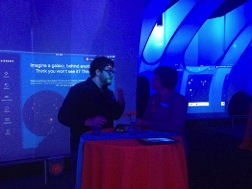Adler show opens world of wonder


Even the entrance to the “Cosmic Wonder” sky show at the Adler Planetarium gives reason for wonder.
Wondering about the universe gives Adler Planetarium astrophysicists and astronomers a reason to act as detectives, piecing together parts of the mystery one clue at a time.
Adler will give the public reasons for wonder May 17 with the opening of the “Cosmic Wonder” sky show and a summer-long program, “100 Days of Wonder.”
As viewers enter the show, they’ll see a quote from astronaut Neil Armstrong: “Mystery creates wonder and wonder is the basis of man’s desire to understand.”
The moon, on which Armstrong was the first to walk, inspired the show, said Michelle Larson, an astrophysicist and president and CEO of the Adler Planetarium.
“Let’s look up and think about what’s up there and what might it be,” she said.
Adler hosted a media preview of the sky show Wednesday and opened the audience to a class from Irving Park’s Frank Reilly Elementary as well.

Adler Planetarium President and CEO Michelle Larson interacts with new gravitational lens technology.
“I felt like I was there,” said sixth grader Jasmine Vargas.
Audience members received moon-shaped pennies to compare their size and weight to that of neutron stars, the heart of supernova remnants that exist as the result of tremendous explosions that mark the death of stars.
“This neutron star is the last stage before a black hole, where everything collapses to a point where all of the particles are jammed together and the space is gone,” said astronomer Mark SubbaRao, director of the Adler Planetarium’s Space Visualization Laboratory.
If a penny were made of neutron-star material, it would weigh more than all of the buildings in the city of Chicago combined.
The neutron star at the heart of the crab nebula, a well-known supernova remnant, weighs more than the sun, but is only the size of the city of Chicago.
And without the supernova, pennies wouldn’t exist – elements such as copper and zinc as well as the calcium in bones and iron in blood were forged in stars and released in supernovas.
Small wonders like this will be featured in the summer-long program incorporating and surrounding the showing of “Cosmic Wonder.” As another part of the program, the Adler will unveil a full-size replica of NASA’s Curiosity Rover, the size of a small SUV. The rover found evidence last year of liquid water on the red planet.
“There are different ways we can explore the universe,” said Julian Jackson, director of experience design and shows. “We can look through telescopes, we can send probes and rovers, we can even just look up in the night sky. They’re all different ways we can think about and explore what’s around us.”
Another way exploration is taking place at Adler is through a hands-on, interactive scientific experiment with the Citizen Science project called Space Warps. Members of the Citizen Science team have moved to the museum floor to complete technical work while interacting with the public.
The experiment will allow people to interact with science through iPads and projection screens that help detect the existence of dark matter, the mysterious substance believed to provide gravitational glue for the galazies, as Albert Einstein once theorized.
A phenomenon called an Einstein Ring can also be occasionally detected when the alignment is just right, showing a ring of light from a background object around the foreground object, according Arfon Smith, Citizen Science director.
Gravitational lenses, which allow observers to see light bending around objects invisible to the naked eye, are helping scientists in this project unearth the mystery of dark matter.
“Gravity actually bends light. Just like when light passes through a lense it gets bent, when light passes through space and there’s a large gravitational mass there, the space curves and light bends. So this is a way to tell us that something is there,” Larson said.
She said the goal of the project is to allow citizens to take part in science while also allowing scientific tools, such as the identification of these gravitational lenses, to advance the entire scientific community.
“Computers are not as good as humans at spotting these things,” Smith said. “This is actually a running theme with the Citizen Science program here: we build projects where people are still better than computers at some things and this turns out to be a lot of things, especially in astrophysics. These are fun projects to have the public help us with but they produce real scientific output as well.”
Arfon said Space Warps will be Citizen Science’s 15th initiative, the first having taken place in 2007. That first experiment, Galaxy Zoo, has resulted in over 35 publications.
Citizen Science’s projects can be found online at www.zooniverse.org and Adler’s summer program online at www.adlerplanetarium.org. projects can be found online at www.zooniverse.org and Adler’s summer program online at www.adlerplanetarium.org.